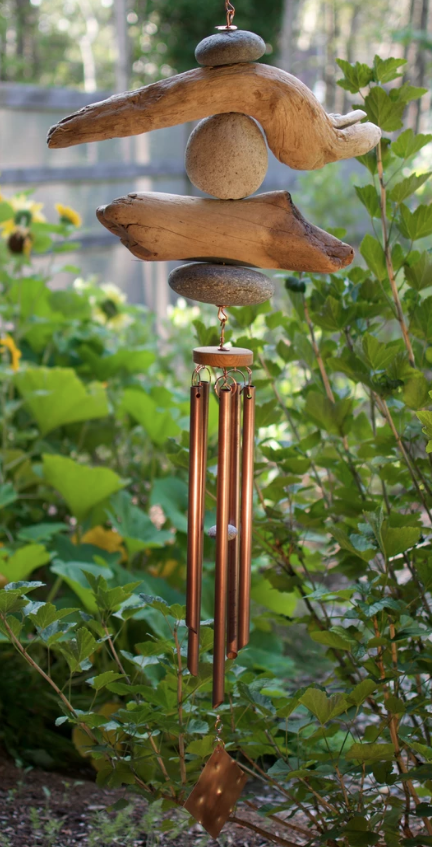Coast Chimes: The Signature Sound of Copper
 Coastal Chimes copper windchime featuring natural
Coastal Chimes copper windchime featuring natural elements owner Tim Kline.
Photograph courtesy of Tim Kline.
Tim Kline is a husband, father, artist, beachcomber and list-maker who counts living just two minutes away from the ocean as one of his great fortunes.
For the past 25 years, Kline has incorporated many raw materials from the beach into his custom copper windchimes and suncatchers.
The musical works of art hang from copper wire, which he strings oyster shell, stones, driftwood and beach glass onto. His trademark is the wire wrapping that holds the suspended beach stones and glass in place. Many of his designs are colorful, while others are monochromatic and earthy, with a zen quality.
“I’m never leaving copper,” he said.“It’s almost magical what you can do with it.”
Kline chose copper for its beauty and softness. Compared to other metals, copper strikes the right mellow sound for his wind chimes.
One customer testimony commented that the “Melodic sounds combined with an aesthetic beauty that conveys subtle, but very present presence describes this lovely wind chime.”
And while Kline doesn’t tune his chimes, he did explore lots of different materials in the early days.
“I kept coming back to copper because it’s such an amazing material,” he said.
The rosy hue of copper is familiar and approachable.“It’s a high quality material,” Kline said. “People know it. It is just outstanding. And it just goes so well with the natural materials.”Copper is durable and elicits a pretty, tinkling sound that’s never annoying.
“Early on I had a problem with flatness,” he said of the sound of his wind chimes.
But since he began using copper, “Everyone agrees, it sounds good,” he said.
From the various finishes to the rich patina of aged copper, it’s a material he committed to 20 years ago. To keep things simple, Kline buys copper pipe from a local building supply store and cuts it to his specifications. And Coast Chimes are never powder-coated. His process, he concedes, is labor intensive. He does all of the work by himself, using a chop saw to cut the copper pipe and a drill press to make holes in the stones, beach glass and shells.
He applies a product that reacts with copper to “kick-start the patina to get the old penny look,” Kline said. Then the copper goes in a water bath and gets rubbed.
“I have a really solid foundation,” said Kline, who works out of his home, where he has a gallery.
Kline got his start in the late 1990s, when internet shopping was new, and he stumbled upon eBay, a worldwide marketplace for artists.
“You could do anything and get a reaction; eBay was absolutely a fantastic start for artists,” Kline said. At the time, Kline’s youngest son collected feathers, bottle caps and beach glass. On a whim, Kline posted some of his son’s creations on eBay, and 15 of the pieces sold within a week, earning about $30.
Lo and behold, a customer asked for a wind chime. So Kline made one.
“That first one – oh, boy. That got attention!” he said. “The bidding was phenomenal.”
His first wind chime sold for $300.
In 2005, Kline carved out a niche on Etsy, the advantage being that wind chimes stand out more than, say, pottery or jewelry. A large, free-standing wind chime shares space alongside a Marc Chagall painting in the home of a New York City collector.
“It’s nice,” says the soft-spoken artist, who no longer makes large, free-standing pieces.
But Kline gets just as much of a thrill out of making the small and large chimes priced at $58 to $275.
He can look at a pile of driftwood and know exactly what to do with it.
“My work is so varied, it doesn’t get stale,” he said. “I just love it.”
Resources:
Also in this Issue:
- Phenomenal Nature: Mukherjee Retrospective opens at the Met
- Custom Copper Designs with a Twist
- Coast Chimes: The Signature Sound of Copper
- A.E. Seaman Mineral Museum: Preserving A Monumental Copper Discovery for Generations
- Peter Voulkos: Merging Ceramic and Bronze
